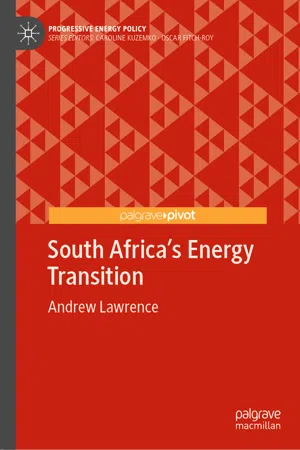This book addresses a deceptively simple question: why has South Africa failed to substantially transition from polluting and more expensive fossil fuel reliance to cleaner, cheaper, and more abundant renewable energy (RE) sources such as wind and solar power? Admittedly, the same question can be posed to most other countries—in particular, those with major fossil fuel industries: this “non-event” is a global, rather than local, phenomenon. Hydrocarbons continue to provide 80% of global energy supplies. Electricity generation worldwide from oil, coal, and natural gas—although declining slightly in recent years to around two-thirds of total generation—remains far higher than its level of under 52% in 1986; whereas generation from renewable sources (hydro, wind, solar and geothermal) has increased only slightly, from 19% since 1986 to about 23%. There remains substantial national variation: more than 40 countries (including at least a dozen in sub-Saharan Africa) generate most of their electricity from RE sources, including perhaps a dozen generating at or close to 100% from them; more than 30 others generate between a quarter and a half from RE sources.1
This question nonetheless is particularly relevant to South Africa: its total domestic electricity generation capacity is 51.3 gigawatts (GW), of which the overwhelming majority, 91.2% (46.8 GW), comes from thermal (almost all coal-fired) power stations, with the 8.8% balance (4.5 GW, of which 3.8 GW is currently operational) installed RE capacity.
2 Despite recent
increases in RE capacity,
consumption from RE sources has increased more slowly. As Table
1.1 shows, South Africa’s RE consumption in 2015 was only a tenth of the world average; at less than 5% of generated electricity, it lags behind both Organization for Economic Cooperation and Development (OECD) and African averages.
3 Table 1.1Top ten coal producing/generating countries and their RE generation, 2015
Rank | Country | Coal production, 2015 MT | Coal-generated electricitya (%) | Electricity from RE sources (%) (non-hydro + hydro) |
|---|
1 | China | 3874.0 | 70.3 | 4.9 + 19.1 = 24 |
2 | United States | 906.9 | 34.2 | 7.4 + 5.8 = 13.2 |
3 | Australia | 644.0 | 62.9 | 8.3 + 5.3 = 13.6 |
4 | India | 537.6 | 75.3 | 5.4 + 10 = 15.4 |
5 | Indonesia | 458.0 | 55.8 | 4.8 + 5.9 = 10.7 |
6 | Russia | 357.6 | 14.8 | 0.1 + 15.8 = 15.9 |
7 | South Africa | 260.5 | 92.7 | 1.9 + 0.3 = 2.2 |
8 | Germany | 185.8 | 44.3 | 26.3 + 3 = 29.3 |
9 | Poland | 137.1 | 80.9 | 12.7 + 1.1 = 13.8 |
10 | Kazakhstan | 108.7 | 71.6 | 0.2 + 8.7 = 8.9 |
| | WORLD | 8277.9 | 39.2 | 6.8 + 15.9 = 22.7 |
“Coal” is indeed the deceptively simple answer to this question. For several years, South Africa has ranked seventh in the world for total amount of coal mined (and third for tons per capita), first among larger economies for the percentage of electricity generation dependent on coal, and conversely, last for the percentage of electricity generated from renewable energy sources including solar, wind, and hydroelectric generation (Table 1.1). Although coal’s rank among South Africa’s top ten exported commodities has slipped over the past decade, it remains high: in 2016, South Africa’s sales of 69 million tons of coal, at $4.57 billion, were its fourth most valuable mineral export, after gold ($20.7 billion), diamonds ($10.9 billion), and platinum ($8.53 billion), contributing 4.5% of export revenue.4 Notably, however, South Africa’s local sales of roughly 183 million tons of coal generated levels of revenue more than 20% higher than did coal exports.5
Price, however, is not a plausible explanation for the relative tardiness of South Africa’s energy transition. For several years, RE sources’ cost has fallen ever lower in comparison to coal generation—three years after the introduction of large-scale RE generation, they were 23% cheaper than new coal-based generation.6 Since then, they have become 40% cheaper.7 Although at R0.62/kWh, South Africa’s cost of wind and solar generation per kilowatt hour is still higher than RE costs in other middle- to low-income countries,8 there is no sign that the trend of RE electricity costs falling increasingly below those from fossil-fuel generation will let up in the foreseeable future. The latest available authoritative figures from Lazard show that the costs of unsubsidized, large-scale business utility-level solar and wind power fell in 2017, continuing the trend over the past decade, to levels that are now more than 50% below those of 2013 and thus lower than coal and gas generation costs as well as capital costs.9 The latent potential to increase the diversity of supply options would also strengthen energy security for households, firms, and for the country as a whole. Fuller explanations for South Africa’s energy politics rather should refer to—and can deepen understanding of—the...
